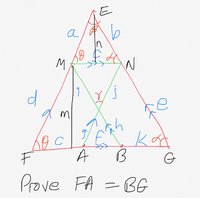Justrandom1
New member
- Joined
- Feb 20, 2020
- Messages
- 7
Want to proof this but seriously didn’t figure as no values or angles were given ?
Ok--I'm a little confused as to what is given and what is not. And what are you trying to prove? Could you throw a little light on this?
OK...that's fine.
Given those parallel lines, what parallelograms do you see?
Do you know the properties of parallelograms?
In parallelogram \(MNAF\) we have \(\overline{MN}\cong\overline{AF}\)
In parallelogram \(MNGB\) we have \(\overline{MN}\cong\overline{GB}\)
Why is that the case? What does that tell you?
That is what the solution says but to prove this in detail
pka said:
Those are well known (Euclid) theorems - about triangle and parallelograms.In parallelogram MNAFwe have ¯¯¯¯¯¯¯¯¯¯¯MN≅¯¯¯¯¯¯¯¯AF
In parallelogram MNGB we have ¯¯¯¯¯¯¯¯¯¯¯MN≅¯¯¯¯¯¯¯¯GB
Why is that the case? What does that tell you?
https://www.freemathhelp.com/forum/goto/post?id=483443
Those are well known (Euclid) theorems - about triangle and parallelograms.
Are you expected to provide proof of those?
Line segments congruent to each other are equal in length.Yes proof of those two sides mentioned are equal
The OP stated the given, showed the diagram and stated what was to be proved. I guess you want to the see the proof as well. Come on!Ok--I'm a little confused as to what is given and what is not. And what are you trying to prove? Could you throw a little light on this?

I thought that the definition of a parallelogram is a quadrilateral where both pairs of opposite sides are parallel and congruent. Then the proof follows just as pka stated.https://www.freemathhelp.com/forum/goto/post?id=483443
Those are well known (Euclid) theorems - about triangle and parallelograms.
Are you expected to provide proof of those?
My goodness...I never knew anyone so argumentative.The OP stated the given, showed the diagram and stated what was to be proved. I guess you want to the see the proof as well. Come on!
"I thought that the definition of a parallelogram is a quadrilateral where both pairs of opposite sides are parallel and congruent." - NO!I thought that the definition of a parallelogram is a quadrilateral where both pairs of opposite sides are parallel and congruent. Then the proof follows just as pka stated.
@Subhotosh Khan: Why would you say that these are well known theorems as opposed to definitions? Can you please tell me your definition of a parallelogram? I know that some people use a different definition and prove a theorem which I would call the definition. Just curious. Thanks!
